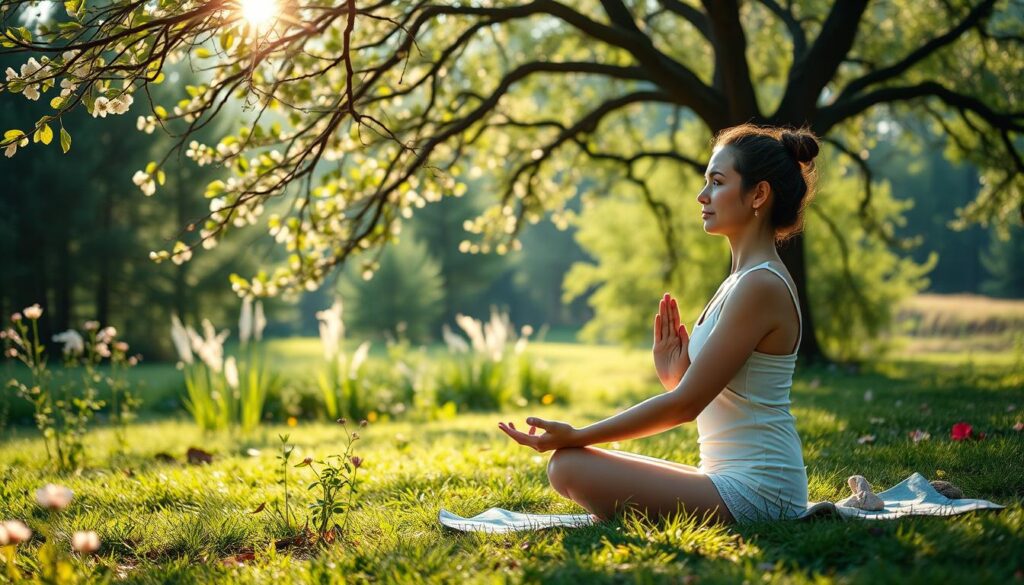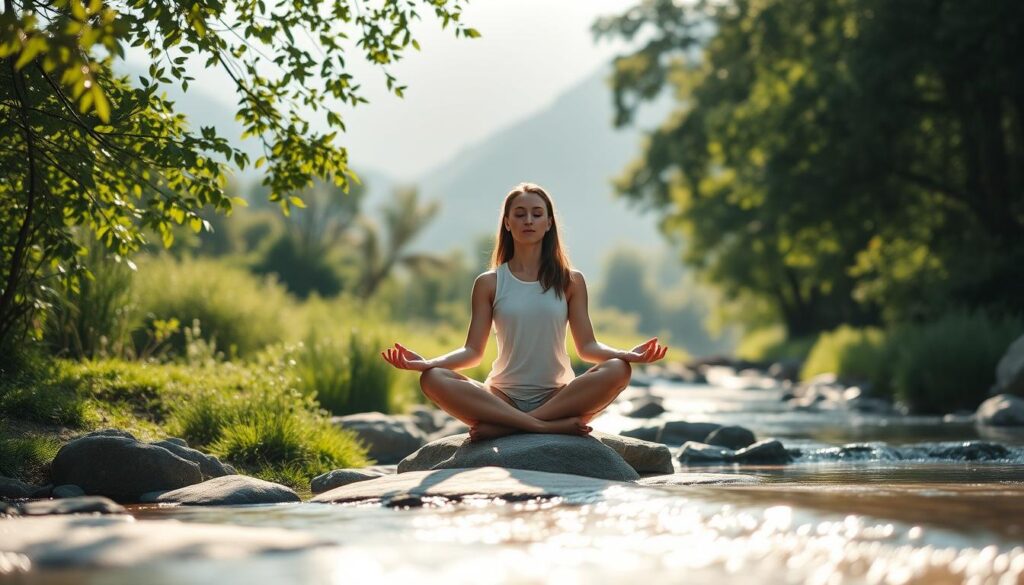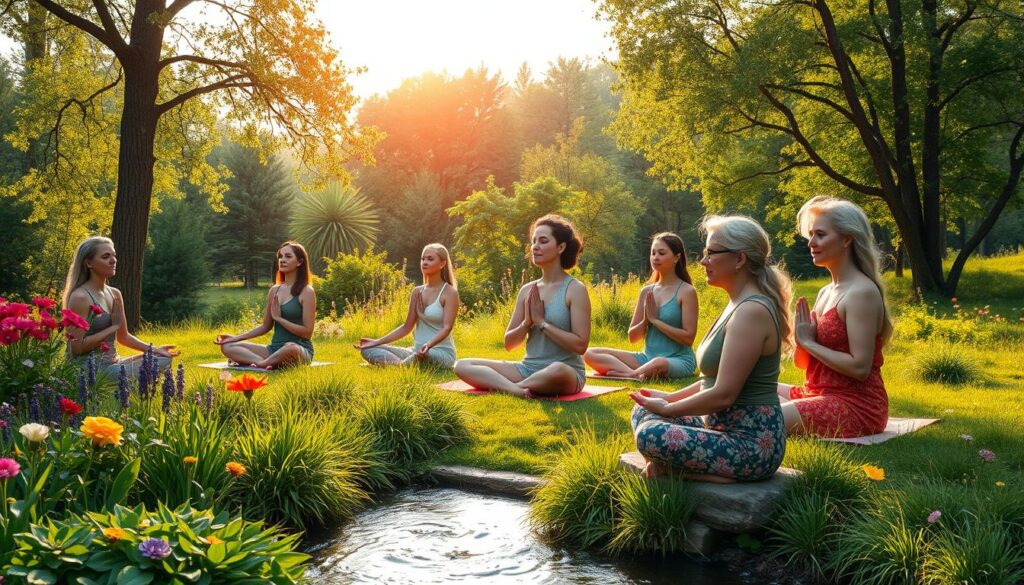In today’s fast world, many of us seek a deeper connection and peace. We face daily challenges or want to grow personally. Spiritual practices help us find mindfulness, reduce stress, and understand ourselves and the world better. Remember, spirituality is personal and unique to each of us.
This guide explores spiritual practices like mindfulness, meditation, yoga, and mindful living. We’ll learn about their benefits and how to use them in our lives. This can help us feel more aware, emotionally intelligent, and well. Whether you’re new or looking to deepen your practice, this guide will help you.
Mindfulness helps us observe our thoughts and feelings without judgment. It teaches us to breathe consciously and connect our body and mind. These practices reduce stress, improve clarity, and bring inner peace. By being open and reflective, we can see how spirituality changes our lives.
Key Takeaways
- Spirituality is a personal journey that can help us find inner peace and connection in a chaotic world.
- Mindfulness, meditation, and yoga are powerful practices for cultivating present moment awareness and reducing stress.
- Integrating spiritual practices into daily life can foster emotional intelligence and overall well-being.
- Conscious breathing and mind-body connection exercises are essential tools for developing a deeper sense of inner peace.
- Approaching spiritual practices with an open mind and a willingness to engage in self-reflection is key to unlocking their transformative power.
The Importance of Spirituality in Our Lives
Spirituality shapes our beliefs and values, giving us a unique outlook on life. It’s a personal journey that helps us through life’s ups and downs. Whether we seek it or not, our beliefs deeply influence our thoughts and actions.
A study from April 2008 to March 2010 looked at Mindfulness-Based Stress Reduction (MBSR) programs. It found that 90.2% of participants wanted to improve their mental health. Also, 89.3% aimed to manage stress. Interestingly, 49.6% wanted to explore or deepen their spirituality through the course. This shows a strong link between mindfulness and spiritual growth.
Understanding the Role of Spirituality
Spirituality acts as a guiding light in our lives. It helps us understand our purpose and values. It also connects us to something greater than ourselves.
Research shows mindfulness meditation improves our physical and mental health. A study found it reduces stress and treats heart disease. It also lowers blood pressure and improves sleep.
The Impact of Spiritual Beliefs on Personal Growth
Our spiritual beliefs shape our personal growth. They influence how we see ourselves and the world. Spiritual practices like meditation help us understand ourselves better.
Spirituality gives us a sense of purpose. It helps us align our actions with our values. This journey of self-discovery leads to personal growth and transformation.
What comes into our minds when we think about God is the most important thing about us.
Spirituality is crucial in our lives. It provides comfort, guidance, and a sense of connection. By nurturing our spiritual needs, we can live more meaningful lives filled with love and inner peace.
Mindfulness: The Path to Present Moment Awareness
Mindfulness is a powerful practice that helps us stay in the present moment. It lets us see life more clearly and feel more compassion and peace. By being mindful, we learn to observe our thoughts and feelings with curiosity, gaining a deeper understanding of ourselves and the world.

Studies show that mindfulness can greatly improve our mental and physical health. It changes our brain, helping us focus better, manage emotions, and handle stress. Regular mindfulness practice makes us calmer and clearer, helping us deal with life’s ups and downs.
What is Mindfulness?
Mindfulness is about paying full attention to the now, without judgment. It’s about noticing our thoughts, feelings, and body sensations with kindness. This practice helps us be more understanding and kind to ourselves and others.
Mindfulness is the gentle effort to be fully present, in a nonjudgmental way.
Mindfulness is always available to us, through meditation, body scans, and other exercises. Regular practice increases our awareness and presence. This helps us face life’s challenges with clarity and strength.
Benefits of Mindfulness Practice
Mindfulness has many benefits for our mind and body. Regular practice can lead to:
- Less stress, anxiety, and negative feelings
- Better focus and concentration
- Improved emotional control and resilience
- More inner peace and well-being
- Increased kindness and empathy towards ourselves and others
- Better physical health, including a stronger immune system and lower blood pressure
Mindfulness gives us space to react differently, breaking free from old patterns. It helps us see things more clearly, making it easier to handle life’s challenges.
Techniques for Cultivating Mindfulness
There are many ways to practice mindfulness every day. Some effective methods include:
- Mindful breathing, focusing on the breath
- Body scans, noticing body sensations
- Setting intentions, clarifying our purpose
- Self-reflection through journaling, exploring our thoughts and feelings
- Seeking quiet moments for reflection
By adding these techniques to our daily life, we can build a strong mindfulness practice. This brings us peace, clarity, and well-being.
| Mindfulness Practice | Key Benefits |
|---|---|
| Mindful Breathing | Reduces stress, improves focus and concentration |
| Body Scans | Enhances body awareness, promotes relaxation |
| Setting Intentions | Clarifies purpose, cultivates motivation and commitment |
| Self-Reflection and Journaling | Increases self-awareness, fosters emotional intelligence |
| Moments of Stillness | Creates space for inner peace, enhances mindful presence |
Exploring mindfulness opens us to a world of awareness, compassion, and peace. By practicing mindfulness, we can change how we see ourselves, others, and the world. We discover a deep well of wisdom and resilience within.
Meditation Practices for Inner Peace
Meditation is a powerful tool for finding inner peace. It helps us reduce stress and improve focus. By using different meditation techniques, we can connect more deeply with ourselves.
Meditation helps us relax and release tension. It brings calmness that stays with us beyond our sessions. This calm mindset helps us face daily life more peacefully.
Meditation also boosts our immune system. It reduces stress and promotes balance, helping our bodies fight off illnesses better. This makes us stronger and more resilient.
It also makes us better at connecting with others. Meditation increases our mindfulness and empathy. This leads to deeper, more meaningful relationships in all areas of life.
| Meditation Technique | Benefits | Recommended Duration |
|---|---|---|
| Mindfulness Meditation | Reduces stress, improves focus, enhances self-awareness | 10-20 minutes daily |
| Loving-Kindness Meditation | Cultivates compassion, strengthens relationships, promotes emotional well-being | 15-20 minutes daily |
| Body Scan Meditation | Reduces tension, improves sleep, enhances mind-body connection | 10-30 minutes daily |
| Mantra Meditation | Calms the mind, improves concentration, deepens spiritual connection | 10-30 minutes daily |
Adding meditation to our daily routine is easy. Just set aside a few minutes each day to sit quietly and focus on our breath. This practice brings us closer to inner peace and spiritual connection.
Meditation is a way of learning how to let go. It’s learning how to be in the present moment, how to live life more deeply, and how to be at peace with ourselves and with the world around us.
By using meditation for spiritual growth, we open up to inner peace and clarity. Regular practice and an open heart can change our lives and connect us to the divine within us.
Yoga: Uniting Mind, Body, and Spirit
Yoga is a practice that connects our physical, mental, and spiritual sides. It uses asanas, pranayama, and meditation to link body, mind, and spirit. Regular yoga practice brings spiritual benefits that go beyond the mat.

The History and Philosophy of Yoga
Yoga started in ancient India over 5,000 years ago. It believes that uniting mind, body, and spirit leads to self-realization. The Yoga Sutras by Patanjali guide spiritual seekers. The eight limbs of yoga help in personal growth and spiritual development.
Different Styles of Yoga Practice
There are many yoga styles, each with its own focus. Some well-known styles include:
- Hatha Yoga: A gentle practice focusing on postures, breathing, and relaxation.
- Vinyasa Yoga: A dynamic practice linking breath with movement in a flowing sequence.
- Kundalini Yoga: A practice that awakens spiritual energy through kriyas, chanting, and meditation.
- Yin Yoga: A slow-paced practice targeting connective tissues for deep relaxation.
Yoga’s essence is the same across styles – to cultivate mindfulness and inner peace. Exploring different yoga styles helps us find what suits us best.
Spiritual Benefits of Yoga
Yoga’s spiritual benefits are deep and transformative. Regular practice brings:
- Increased self-awareness and introspection
- Cultivation of inner peace and tranquility
- Enhanced connection to the present moment
- Greater sense of unity and interconnectedness
- Deepening of spiritual insights and wisdom
Yoga is the journey of the self, through the self, to the self. – The Bhagavad Gita
Embracing yoga’s spiritual aspects starts a journey of self-discovery. Through asanas, pranayama, and meditation, we connect deeply with ourselves and the world. Yoga helps us find inner peace and clarity in daily life.
Yoga is a powerful tool for spiritual growth and personal evolution. It unites mind, body, and spirit, offering wisdom, inner peace, and self-realization. Whether seeking physical well-being, emotional balance, or spiritual enlightenment, yoga is a path to deeper understanding.
Exploring the Concept of Mindful Living
Mindful living changes how we live every day. It’s about being aware in the moment and choosing what we consume carefully. This helps us connect better with ourselves, others, and the world.
Studies show that just 5-10 minutes of mindfulness a day can help a lot. It can lower depression, anxiety, and stress. It also improves sleep, digestion, and overall health. By adding mindfulness to our daily lives, we can find peace and clarity.
Applying Mindfulness to Daily Life
Mindful living means being fully present in our daily tasks. Whether walking, cooking, or talking, mindfulness helps us stay in the moment. Here are some easy ways to do it:
- Taking a few deep breaths before starting a new activity
- Paying attention to our body’s sensations
- Listening fully to others without judgment
- Noticing the beauty around us
By doing these small things, we can change how we see ourselves and the world. It leads to a more fulfilling and connected life.
Mindful Eating and Conscious Consumption
Mindful eating means eating with full attention. It’s about enjoying each bite and appreciating our food. This helps us make better choices about what we eat.
Conscious consumption is more than just food. It’s about the media, products, and our impact on the world. By being mindful in our choices, we can live more sustainably and with compassion.
| Mindfulness Practice | Benefits |
|---|---|
| 5-10 minutes of daily practice | Reduced stress, anxiety, and depression |
| Mindful eating | Improved digestion and healthier food choices |
| Conscious consumption | Alignment with personal values and reduced environmental impact |
Mindfulness is a way of befriending ourselves and our experience. – Jon Kabat-Zinn
By living mindfully and adding mindfulness to our daily lives, we can feel more present and connected. Through mindful choices, we can live in a way that aligns with our values and helps the world.
Stress Reduction Techniques for Spiritual Well-being
In today’s fast world, stress is common. It affects our body, mind, and spirit. But, there are ways to reduce stress and find peace. Mindfulness meditation is one effective method. It helps lower stress, anxiety, and other issues.

Mindfulness exercises like body scan and walking meditation improve focus and sleep. Being outdoors while meditating also helps reduce stress. It boosts our spiritual well-being.
“Meditation is not a way of making your mind quiet. It’s a way of entering into the quiet that’s already there.” – Deepak Chopra
Other ways to reduce stress and nurture our spirit include:
- Regular yoga practice, which combines physical movements, breath control, and meditation to calm the mind and reduce stress
- Breathing exercises, such as alternate nostril breathing or deep belly breathing, which can help quiet the mind, increase energy flow, and enhance mindfulness
- Practicing self-compassion and letting go of self-judgment, treating ourselves with love and kindness both on and off the yoga mat
| Technique | Benefits |
|---|---|
| Mindfulness Meditation | Reduces stress, anxiety, pain, depression, insomnia, and high blood pressure |
| Yoga | Calms the mind, reduces stress, and promotes inner peace |
| Breathing Exercises | Quiets the mind, increases energy flow, and enhances mindfulness |
| Self-Compassion | Reduces stress and promotes a more peaceful relationship with oneself |
For lasting benefits, practice these techniques daily for six months. By doing so, we can deepen our spiritual well-being. We’ll find peace and handle life’s challenges better.
Developing Emotional Intelligence through Spiritual Practices
Emotional intelligence (EQ) is key for personal growth and spiritual development. It helps us understand and manage our emotions. This leads to better relationships, success at work, and overall well-being.

Mindfulness, meditation, and yoga are important for EQ. They help us understand ourselves better. By focusing on our thoughts and feelings, we learn to manage them well. This way, we can connect with others more deeply.
Understanding Emotional Intelligence
EQ includes self-management, self-awareness, social awareness, and managing relationships. These skills help us handle complex situations and lead others. Many companies now value EQ as much as technical skills when hiring.
People with high EQ do well in life and work. 83% of top performers have high EQ, unlike 2% of those who struggle. This shows how crucial self-awareness is for EQ.
Spiritual Practices for Enhancing Emotional Intelligence
Practices like mindfulness boost EQ. Mindfulness helps us stay present and understand our emotions better. This leads to emotional balance.
Regular mindfulness meditation improves our emotional understanding and control.
Yoga also helps EQ by encouraging self-reflection. It combines physical postures, breathing, and meditation. This helps us understand ourselves and our emotions better.
Journaling and self-inquiry are also useful for EQ. They help us reflect on our experiences and emotions. This way, we can make better choices in our interactions.
| Spiritual Practice | Benefits for Emotional Intelligence |
|---|---|
| Mindfulness | Enhances self-awareness, emotional regulation, and empathy |
| Yoga | Encourages self-reflection, introspection, and emotional balance |
| Meditation | Improves ability to understand and control emotions, reduces stress |
| Journaling | Promotes self-awareness, insight into patterns and behaviors |
By adding these practices to our lives, we can grow emotionally. This leads to better relationships, well-being, and success in all areas of life.
The Power of Conscious Breathing
Conscious breathing is key in spiritual practices. It connects our physical and spiritual sides. By focusing on our breath, we find relaxation, clarity, and inner peace.
Breathing Techniques for Relaxation and Clarity
Adults breathe 12 to 20 times a minute, or 28,800 times a day. But it’s not just how many breaths we take that matters. It’s the quality of those breaths. Techniques like the 4-7-8 method help us relax and think clearly.
Other methods, like diaphragmatic breathing and the Wim Hof method, also reduce stress. They improve our overall well-being.

Yogic breathing, or pranayama, is another powerful tool. Studies show it improves breathing and circulation in people with asthma and cancer. It also boosts brain activity and metabolism.
| Breathing Technique | Benefits |
|---|---|
| 4-7-8 Breathing | Promotes relaxation, reduces anxiety |
| Diaphragmatic Breathing | Improves oxygen uptake, reduces stress |
| Box Breathing | Calms the nervous system, enhances focus |
| Wim Hof Method | Boosts immune function, increases energy |
The Connection between Breath and Spirituality
The word ‘spirituality’ comes from ‘spiritus,’ meaning ‘breath.’ This shows how deeply connected our breath is to our spirit. Focusing on our breath helps us feel present and connect with ourselves and the world.
“Breath is the bridge which connects life to consciousness, which unites your body to your thoughts.” – Thich Nhat Hanh
Conscious breathing offers many benefits. It improves our mood, sleep, blood pressure, and breathing. It also helps with digestion, concentration, and nervous system regulation. By using these techniques, we can grow spiritually and find inner peace.
Through yogic breathing, mindfulness, or simple exercises, our breath can lead to spiritual growth. As we connect with our breath, we open up to healing, insight, and connection.
Non-Judgmental Observation: A Key to Spiritual Growth
Non-judgmental observation is key to mindfulness and spiritual growth. It means watching our thoughts and feelings without judging them. This way, we learn to accept and understand ourselves and others better.
Mindfulness practices like sitting meditation help us observe without judgment. These practices make us more aware of our inner world. A study shows that regular mindfulness practice deepens our skills and understanding over time.
Using mindfulness apps or guided meditations can help us start. These tools offer structured practices and guidance. Joining mindfulness groups or classes also helps, providing support and a sense of community.
“Mindfulness is a skill that develops over time through consistent practice. Reflecting on experiences and observing how mindfulness impacts daily life can deepen understanding of its benefits.”
Mindfulness can be practiced in daily activities like walking or eating. This approach helps us stay present and promotes spiritual growth. By not judging our thoughts, we find inner peace and calm.
- Cultivate gratitude by reflecting on things to be thankful for, promoting mindful appreciation of the present moment.
- Extend mindfulness beyond formal meditation sessions, practicing during everyday tasks to foster a consistent state of mindfulness.
- Develop patience and an open, curious mind, as mindfulness skills require time and dedication to cultivate.
| Mindfulness Practice | Benefits |
|---|---|
| Regular meditation | Deepens skills and enhances mindfulness capabilities |
| Mindfulness apps or guided meditations | Provides structured practices and guidance for skill development |
| Joining mindfulness groups or classes | Offers support, community, and opportunities to learn from experienced practitioners |
| Incorporating mindfulness into daily activities | Enhances overall mindfulness experience and promotes spiritual growth |
By embracing non-judgmental observation and integrating mindfulness into our lives, we grow spiritually. We learn to accept ourselves and connect deeply with the present. This journey brings us peace, clarity, and understanding, enriching our lives and relationships.
Exploring the Mind-Body Connection
The mind-body connection is a fascinating concept. It shows how our mental and physical states are linked. Our thoughts and feelings can greatly affect our health, and our health can also impact our mind and emotions.
By understanding and caring for this connection, we can achieve a holistic well-being. This leads to a more fulfilling life.
The Interplay between Physical and Mental Well-being
Research has shown that our emotions can show up in our bodies. A 2013 study found that emotions like happiness and anger affect different parts of our body. This shows a deep connection between our mental and physical states.
| Emotion | Body Activation |
|---|---|
| Happiness | Fills the whole body with activity, signifying physical readiness and heightened communication between body and brain. |
| Love | Activates the whole body, with a focus on the reproductive organs due to its association with physical desire. |
| Pride | Activates the head and chest areas intensely, drawing resources and awareness inwards. |
| Anger | Shows intense activation in the head, chest, and hands, preparing the body for conflict. |
| Fear | Has a less pronounced but similar activation pattern to anger, preparing the body for fight-or-flight responses. |
| Disgust | Focuses activation along the digestive tract, preparing the body to expel noxious substances. |
| Anxiety | Activates the chest intensely and can lead to a sense of dread, often experienced with tightness and pain in the chest. |
| Depression | Stimulates no activation in any part of the body and lowers activation in the extremities, leading to a disconnect with the active self and the outside world. |
Understanding these connections helps us see how our mental state affects our body and vice versa. By strengthening the mind-body connection, we can improve our physical health and emotional well-being. We also reduce stress, increase self-awareness, and enhance our cognitive function and resilience.
Spiritual Practices for Nurturing the Mind-Body Connection
Practices that combine physical and mental activities can strengthen the mind-body connection. This promotes unity and balance within ourselves. Examples include:
- Yoga: A holistic practice that acknowledges and nurtures the mind-body connection through physical postures, breath work, and meditation.
- Tai Chi: A gentle, flowing form of exercise that combines slow, graceful movements with deep breathing and meditation.
- Qigong: A traditional Chinese practice that involves coordinated body postures, movements, breathing, and meditation.
Incorporating these practices into our daily lives can deepen our self-awareness and inner peace. As we explore and nurture the mind-body connection, we move towards a more harmonious and fulfilling existence.
A Guide to Mindfulness: Practical Tips and Techniques
Mindfulness has become very popular lately. It helps us feel better mentally and less stressed. By adding mindfulness to our daily lives, we can feel more present and peaceful. This guide will show you how to start a mindfulness routine that works for you.
Setting Intentions for Mindfulness Practice
Before starting your mindfulness practice, think about what you want to achieve. Maybe you want to feel less stressed or more self-compassionate. Setting intentions makes your practice more focused and rewarding.
Here are some tips for setting your intentions:
- Think about what you want to achieve
- Be clear and realistic with your goals
- Write down your intentions and check them often
- Be open and curious during your practice
Creating a Mindfulness Routine
Being consistent is key to enjoying mindfulness. A regular routine helps you stick with it. Here are some tips for a good routine:
- Choose a time and place for your practice
- Start with short sessions and grow them
- Try different techniques to find what works for you
- Use mindfulness in everyday activities
- Be patient and kind to yourself as you build your routine
Overcoming Challenges in Mindfulness Practice
Starting a new habit can be tough. You might get distracted, restless, or judge yourself too harshly. But don’t worry, these are normal challenges. Just be patient, kind to yourself, and start again when needed.
Remember, mindfulness takes time to get better. Be gentle with yourself and celebrate your small wins.
Here are some ways to deal with common challenges:
| Challenge | Strategy |
|---|---|
| Distraction | Gently bring your focus back to the present |
| Restlessness | Notice the restlessness and focus on your breath or body |
| Self-judgment | Watch your thoughts without judgment and be kind to yourself |
By using these tips, you can build a strong mindfulness practice. Remember, mindfulness is a journey of self-discovery. Enjoy the process and the benefits it brings.
Integrating Spirituality into Daily Life
Adding spirituality to our daily lives can greatly improve our well-being and happiness. A study by HFR (Helping Folks Remember) shows more people are interested in this. They are looking to make spirituality a part of their everyday.
Practices like meditation, prayer, and reading spiritual texts can keep us grounded. A survey found that 85% of people felt better after starting mindfulness practices. These practices help us stay connected and centered.
Mindfulness is key to spiritual practices. It helps us be more aware and connected. By adding spirituality to our daily lives, we become more present and compassionate. Yoga, for example, has been shown to reduce stress and increase peace in 70% of practitioners.
“The spiritual journey is the unlearning of fear and the acceptance of love.” – Marianne Williamson
Doing acts of service and volunteering can also deepen our spirituality. Research found that 90% of volunteers felt more connected to their spirituality. This shows how important it is to help others.
Other ways to enhance our spiritual lifestyle include:
- Reading spiritual texts to reflect and gain wisdom.
- Keeping the Sabbath for rest and connection with the community.
- Fasting to show discipline and deepen prayer.
- Spending time in nature to relax and appreciate the world.
A study showed that those who reflect and contemplate are 60% more likely to feel fulfilled. This highlights the importance of taking time for reflection.
| Spiritual Practice | Benefits |
|---|---|
| Meditation | Increased self-awareness, reduced stress, improved focus |
| Yoga | Physical and mental balance, increased flexibility, spiritual growth |
| Volunteering | Greater sense of connection to spirituality, increased compassion |
| Spending time in nature | Mindfulness, relaxation, stress relief, appreciation for the environment |
Keeping our bodies healthy through exercise, good food, and sleep is crucial. These habits boost our energy and mood. They help us grow spiritually and fully embrace a spiritual lifestyle.
The Role of Community in Spiritual Practice
Spirituality is a personal journey, but community plays a big role. Being part of a spiritual community gives us a sense of belonging and support. It helps us grow spiritually by learning from others and finding encouragement.
Spiritual communities vary, from churches to groups of like-minded people. They offer a safe space to explore beliefs and get feedback. Regularly connecting with others helps us avoid getting stuck and stay grounded.
Finding Support and Guidance in Spiritual Communities
Finding the right spiritual community can change our lives. It helps us step out of our comfort zones and connect with supportive people. Being part of a community opens doors to personal growth and meaningful relationships.
When looking for a spiritual community, ask yourself these questions:
- Do the beliefs and practices of this community align with my personal spiritual values?
- Does this community provide opportunities for growth, learning, and support?
- Are the members of this community welcoming, inclusive, and respectful of diverse perspectives?
- Can I see myself actively participating in and contributing to this community?
Sharing Experiences and Insights with Others
Being part of a spiritual community means sharing our stories and learning from others. Open dialogue helps us grow, support each other, and gain new insights.
Group practices like meditation circles and yoga classes strengthen our connection. These activities help us deepen our practice and feel united with others.
| Benefits of Sharing Experiences in a Spiritual Community | Examples of Group Spiritual Practices |
|---|---|
|
|
“In a spiritual community, we learn to see the beauty and potential in each person, and to support one another in our journey towards greater wisdom, compassion, and inner peace.”
Embracing community in our spiritual journey opens doors to growth and support. A loving community helps us persevere, learn, and thrive on our spiritual path.
Conclusion
Our journey into spiritual practices has shown us how mindfulness, yoga, and meditation change lives. These practices help us grow personally, making us more aware of ourselves and our feelings. They also bring us peace and calm.
By adding mindfulness to our daily lives, we gain many benefits. We feel less anxious and depressed, our immune system gets stronger, and we handle pain and stress better.
Everyone’s spiritual journey is unique. Some find peace in meditation, others in yoga, and some in mindfulness. The important thing is to be open, curious, and ready to learn and grow.
As we keep exploring these practices, we might discover more about ourselves. We might also feel more connected to the world around us.
Remember, the good we do through spiritual practices affects more than just us. By being mindful, compassionate, and peaceful, we help make the world a better place. Let’s use these ancient practices to guide us through life’s ups and downs.
FAQ
What is mindfulness and how can it benefit me?
Mindfulness means being fully present in the moment without judgment. It can lower stress and boost self-awareness. Through meditation and mindful living, you can find inner peace and connect with yourself and the world.
How can I incorporate yoga into my spiritual practice?
Yoga connects the mind, body, and spirit. Exploring different yoga styles can meet your spiritual needs. It enhances self-awareness, inner peace, and spiritual connection through postures, breathwork, and meditation.
What is mindful living and how can I apply it to my daily life?
Mindful living makes mindfulness part of your daily life. It includes mindful eating and conscious consumption. This way, you live more mindfully and spiritually.
How can I use breathing techniques to reduce stress and enhance my spiritual well-being?
Conscious breathing reduces stress and promotes relaxation. Techniques like alternate nostril breathing can quiet the mind and increase energy. Focusing on your breath connects you with your inner self and boosts spiritual awareness.
What is non-judgmental observation and how can it support my spiritual growth?
Non-judgmental observation means watching your thoughts and feelings without judgment. It fosters compassion and understanding. This practice aids in spiritual growth by helping you navigate your inner world with ease and wisdom.
How can I integrate spirituality into my daily life?
Integrating spirituality means adding spiritual practices to your daily life. This includes setting intentions and practicing mindfulness. It brings a sense of connection and purpose to your daily activities.
What role does community play in spiritual practice?
Community is vital in spiritual practice. It offers support, guidance, and a sense of belonging. Sharing experiences with others deepens your understanding and provides wisdom for growth.

